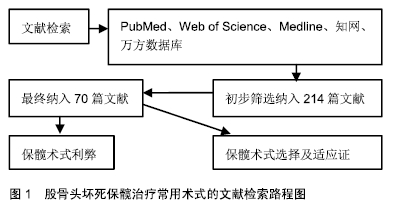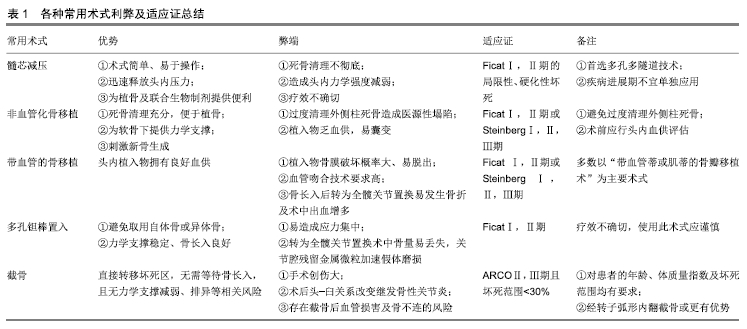[1] ZALAVRAS CG, LIEBERMAN JR. Osteonecrosis of the femoral head: evaluation and treatment. J Am Acad Orthop Surg. 2014;22(7):455-464.
[2] AURÉGAN JC, VILLAIN B, BÉGUÉ T. What is the rate of patients undergoing a total hip arthroplasty after core decompression and insertion of a tantalum rod in osteonecrosis of the femoral head: a systematic review. Int Orthop. 2018; 42(7):1631-1638.
[3] 欧志学,贾晓军,庞智晖,等. 何伟教授治疗股骨头坏死塌陷前期经验介绍[J].新中医,2011,43(5):155-156.
[4] 中国医师协会骨科医师分会显微修复工作委员会, 中国修复重建外科专业委员会骨缺损及骨坏死学组, 中华医学会骨科分会显微修复学组. 成人股骨头坏死临床诊疗指南(2016)[J]. 中华骨科杂志, 2016,36(15):945-954.
[5] ZHANG Y, SUN R, ZHANG L, et al. Effect of blood biochemical factors on nontraumatic necrosis of the femoral head: Logistic regression analysis. Der Orthopäde. 2017; 46(12):737-743.
[6] NAM KW, KIM YL, YOO JJ, et al. Fate of untreated asymptomatic osteonecrosis of the femoral head. J Bone Joint Surg Am. 2008;90(3):477-484.
[7] 中华老年骨科与康复电子杂志编辑委员会.股骨头坏死保髋治疗指南(2016版)[J]. 中华老年骨科与康复电子杂志, 2016, 2(2): 65-70.
[8] 李子荣.骨坏死[M].北京:人民卫生出版社, 2012:183-188.
[9] 刘毓,何伟.何伟教授保髋治疗股骨头坏死塌陷晚期经验介绍[J]. 新中医,2010,42(7):142-144.
[10] FICAT RP, ARLET J. Necrosis of the femoral head// Hungefford DS. Ischemia and necrosis of bone. Baltimore: Williams and ilkins, 1980: 53-74.
[11] FICAT RP. Idiopathic bone necrosis of the femoral head:early diagnosis and treatment. J Bone Joint Surg Br. 1985;67:3-9.
[12] OMRAN AA. Multiple drilling compared with standard core decompression for avascular necrosis of the femoral head in sickle cell disease patients. Arch Orthop Trauma Surg. 2013; 133(5):609-613.
[13] 赵德伟,程亮亮. 国内股骨头坏死保留髋关节手术治疗的十年回顾[J].中华骨科杂志, 2017,37(3):183-192.
[14] BOZIC KJ, ZURAKOWSKI D, THORNHILL TS. Survivorship analysis of hips treated with core decompression for nontraumatic osteonecrosis of the femoral head. JBJS. 1999; 81(2): 200-209.
[15] BELTRAN J, KNIGHT CT, ZUELZER WA, et al. Core decompression for avascular necrosis of the femoral head: correlation between long-term results and preoperative MR staging. Radiology. 1990; 175(2): 533-536.
[16] LAKSHMINARAYANA S, DHAMMI IK, JAIN AK, et al. Outcomes of core decompression with or without nonvascularized fibular grafting in avascular necrosis of femoral head: Short term followup study. Indian J Orthop. 2019;53(3): 420.
[17] HUA KC, YANG XG, FENG JT, et al. The efficacy and safety of core decompression for the treatment of femoral head necrosis: a systematic review and meta-analysis. J Orthop Surg Res. 2019;14(1): 306.
[18] D'AMBROSI R, BIANCARDI E, MASSARI G, et al. Survival analysis after core decompression in association with platelet-rich plasma, mesenchymal stem cells, and synthetic bone graft in patients with osteonecrosis of the femoral head. Joints. 2018;6(1): 16-22.
[19] 赵德伟,谢辉. 成人股骨头坏死保髋手术治疗的策略及探讨[J]. 中国修复重建外科杂志, 2018,32(7):1-5.
[20] ROSENWASSER MP , GARINO JP , KIERNAN HA , et al. Long term followup of thorough debridement and cancellous bone grafting of the femoral head for avascular necrosis. Clin Orthop Relat Res. 1994;(306):17-27.
[21] 何伟,陈镇秋,张庆文,等. 蛙式侧位分型在植骨支撑术治疗酒精性股骨头坏死中的意义[J]. 中华关节外科杂志(电子版), 2011, 5(1):20-23.
[22] 韦标方,韦伟,孙丙银,等. 高位股骨头颈开窗植骨支撑术治疗早期股骨头坏死[J].中华骨科杂志, 2014,34(7): 777-782.
[23] SEYLER TM, MARKER DR, ULRICH SD, et al. Nonvascularized bone grafting defers joint arthroplasty in hip osteonecrosis. Clin Orthop Relat Res. 2008;466(5): 1125-1132.
[24] ZHOU G, ZHANG Y, ZENG L, et al. Should thorough Debridement be used in Fibular Allograft with impaction bone grafting to treat femoral head necrosis: a biomechanical evaluation. BMC Musculoskeletal Disorders. 2015;16(1):140.
[25] WU CT, YEN SH, LIN PC, et al. Long-term outcomes of phemister bone grafting for patients with non-traumatic osteonecrosis of the femoral head. Int Orthop. 2019; 43(3): 579-587.
[26] ZHAO D, XIAOBING Y, WANG T, et al. Digital subtraction angi- ography in selection of the vascularized greater trochanter bone grafting for treatment of osteonecrosis of femoral head. Microsurgery. 2013;33(8):656-659.
[27] FU W, LIU B, WANG B, et al. Early diagnosis and treatment of steroid-induced osteonecrosis of the femoral head. Int Orthop. 2019;43(5): 1083-1087.
[28] QIU X, CHENG L, WANG B, et al. Micro perfusion and quantitative analysis of the femoral head intraosseous artery. Orthop Surg. 2018;10(1): 69-74.
[29] PIERCE TP, ELMALLAH RK, JAUREGUI JJ, et al. A current review of non-vascularized bone grafting in osteonecrosis of the femoral head. Curr Rev Musculoskelet Med. 2015;8(3): 240-245.
[30] FENG Y, WANG S, JIN D, et al. Free vascularised fibular grafting with OsteoSet demineralised bone matrix versus autograft for large osteonecrotic lesions of the femoral head. Int Orthop. 2011;35(4): 475-481.
[31] 田雷,王坤正,党晓谦,等.吻合血管游离腓骨移植治疗股骨头坏死的中期及远期疗效评估[J].中华关节外科杂志(电子版), 2012, 6(6):879-887.
[32] GAO YS , LIU XL , SHENG JG , et al. Unilateral free vascularized fibula shared for the treatment of bilateral osteonecrosis of the femoral head. J Arthroplasty. 2013;28(3): 531-536.
[33] DING H, CHEN SB, GAO YS, et al. Free vascularized fibular grafting for patients receiving postoperative corticosteroids. Orthopedics. 2014;37(4):e357-e361.
[34] ZHAO DW, ZHANG Y, WANG WM, et al. Tantalum rod implantation and vascularized iliac grafting for osteonecrosis of the femoral head. Orthopedics. 2013;36(6): 789-795.
[35] CHEN CC , LIN CL , CHEN WC , et al. Vascularized iliac bone-grafting for osteonecrosis with segmental collapse of the femoral head. J Bone Joint Surg. 2009; 91(10): 2390-2394.
[36] ZENG YR, HE S, FENG WJ, et al. Vascularised greater trochanter bone graft, combined free iliac flap and impaction bone grafting for osteonecrosis of the femoral head. Int Orthop. 2013;37(3): 391-398.
[37] 武殿伟. 吻合血管游离腓骨移植治疗股骨头坏死的手术技巧和效果探讨[J]. 黑龙江医学, 2017,41(11):42-43.
[38] FONTECHA CG, ROCA I, BARBER I, et al. Femoral head bone viability after free vascularized fibular grafting for osteonecrosis: SPECT/CT study. Microsurgery. 2016;36(7): 573-577.
[39] CAO L, GUO C, CHEN J, et al. Free vascularized fibular grafting improves vascularity compared with core decompression in femoral head osteonecrosis: a randomized clinical trial. Clin Orthop Relat Res. 2017;475(9): 2230-2240.
[40] 刘晓琳,盛加根,张长青,等.单侧供体吻合血管游离腓骨移植治疗双侧股骨头缺血性坏死[J].中国修复重建外科杂志, 2011,25(6): 641-645.
[41] URBANIAK JR, COOGAN PG, GUNNESON EH, et al. Treatment of ostenecrosis of the femoral head with free vascularized fibula grafting-a long-term follow-up-study of 103 hips. J Bone Joint Surg Am. 1995;77A: 681-694.
[42] 刘德淮,庄小强,白宇,等. 髓芯减压植骨术与缝匠肌肌骨瓣移植术治疗FicatⅢ期股骨头缺血性坏死的远期疗效比较[J]. 实用骨科杂志, 2014,20(6):495-499.
[43] RYAN SP, WOOSTER B, JIRANEK W, et al. Outcomes of conversion total hip arthroplasty from free vascularized fibular grafting. J Arthroplasty. 2019;34(1): 88-92.
[44] HOUDEK MT, BAYNE CO, BISHOP AT, et al. The outcome and complications of vascularised fibular grafts. Bone Joint J. 2017; 99(1): 134-138.
[45] PEDERSEN DR, BROWN TD, POGGIE RA. Finite element characterization of a porous tantalum material for treatment of avascular necrosis. Trans Orthop Res Soc. 1997; 22: 598.
[46] COHEN R. A porous tantalum trabecular metal: basic science. Am J Orthop (Belle Mead NJ). 2002;31(4):216-217.
[47] TSAO AK. Biomechanical and Clinical Evaluations of a Porous Tantalum Implant for the Treatment of Early-Stage Osteonecrosis. J Bone Joint Surg Am. 2005;87(suppl_2):22.
[48] 钟贵华. 髓芯减压植骨与多孔钽棒植入修复非创伤性股骨头坏死[J]. 中国组织工程研究, 2012,16(29):5501-5505.
[49] LIU B, YANG F, WEI X, et al. An exploratory study of articular cartilage and subchondral bone reconstruction with bone marrow mesenchymal stem cells combined with porous tantalum/Bio-Gide collagen membrane in osteonecrosis of the femoral head. Mater Sci Eng C Mater Biol Appl. 2019;99: 1123-1132.
[50] ZHAO D, LIU B, WANG B, et al. Autologous bone marrow mesenchymal stem cells associated with tantalum rod implantation and vascularized iliac grafting for the treatment of end-stage osteonecrosis of the femoral head. Biomed Res Int. 2015;2015:240506.
[51] LI B, YANG M, YU L. Vascular bundle transplantation combined with porous bone substituted scaffold for the treatment of early-stage avascular necrosis of femoral head. Med Hypotheses. 2019;132: 109374.
[52] VARITIMIDIS SE, DIMITROULIAS AP, KARACHALIOS TS, et al. Outcome after tantalum rod implantation for treatment of femoral head osteonecrosis. Acta Orthopaedica. 2009; 80(1): 20-25.
[53] NADEAU M, SÉGUIN C, THEODOROPOULOS JS, et al. Short term clinical outcome of a porous tantalum implant for the treatment of advanced osteonecrosis of the femoral head. Mcgill J Med. 2007; 10(1):4-10.
[54] ZHAO D, WANG Z, HUANG S. Case report combined therapy of vascularized pedicle bone grafts and tantalum rods for tantalum rod implantation failure. Int J Clin Exp Med. 2018; 11(2): 1027-1032.
[55] 朱刚,张立贵,郑重,等.股骨头坏死区钽棒置入前后应力分布的三维有限元分析[J].中国组织工程研究, 2016,20(26):3883-3889.
[56] ZHANG X, WANG J, XIAO J, et al. Early failures of porous tantalum osteonecrosis implants: a case series with retrieval analysis. Int Orthop. 2016; 40(9): 1827-1834.
[57] AURÉGAN JC, VILLAIN B, BÉGUÉ T. What is the rate of patients undergoing a total hip arthroplasty after core decompression and insertion of a tantalum rod in osteonecrosis of the femoral head: a systematic review. Int Orthop. 2018; 42(7):1631-1638.
[58] MA J, WANG B, YUE D, et al. Outcomes of conversion THA after failed porous tantalum implant for osteonecrosis of the femoral head: a comparative matched study. Hip Int. 2019: 1120700019863036.
[59] CHENG Q, TANG J, GU J, et al. Total hip arthroplasty following failure of tantalum rod implantation for osteonecrosis of the femoral head with 5-to 10-year follow-up. BMC Musculoskeletal Disorders. 2018;19(1): 289.
[60] 刘予豪,周驰,陈雷雷,等 基于股骨头坏死围塌陷期理论的保髋术式总结[J]. 中国修复重建外科杂志, 2017,31(8):120-125.
[61] NISHIO A, SUGIOKA Y. A new technique of the varus osteotomy at the upper end of the femur. Orthop Traumatol. 1971;20(3):381-386.
[62] SUGIOKA Y. Transtrochanteric anterior rotational osteotomy of the femoral head in the treatment of osteonecrosis affecting the hip: a new osteotomy operation. Clin Orthop Relat Res. 1978; (130): 191-201.
[63] LEE YK, LEE B, PARVIZI J, et al. Which Osteotomy for Osteonecrosis of the Femoral Head and Which Patient for the Osteotomy? Clin Orthop Surg. 2019;11(2): 137-141.
[64] KAWANO K, MOTOMURA G, IKEMURA S, et al. Long-term hip survival and factors influencing patient-reported outcomes after transtrochanteric anterior rotational osteotomy for osteonecrosis of the femoral head: A minimum 10-year follow-up case series. Mod Rheumatol. 2019: 1-7.
[65] MORITA D, HASEGAWA Y, OKURA T, et al. Long-term outcomes of transtrochanteric rotational osteotomy for non-traumatic osteonecrosis of the femoral head. Bone Joint J. 2017;99-B(2):175-183.
[66] KARASUYAMA K, MOTOMURA G, IKEMURA S, et al. Risk factor analysis for postoperative complications requiring revision surgery after transtrochanteric rotational osteotomy for osteonecrosis of the femoral head. J Orthop Surg Res. 2018;13(1): 6.
[67] GALLAZZI E, MORELLI I, PERETTI G, et al. What Is the Impact of a Previous Femoral Osteotomy on THA? A Systematic Review. Clin Orthop Relat Res. 2019;477(5): 1176-1187.
[68] PAPAVASILIOU AV, TRIANTAFYLLOPOULOS I, PAXINOS O, et al. The role of cell therapies and hip arthroscopy in the management of osteonecrosis: an update. J Hip Preserv Surg. 2018;5(3):202-208.
[69] 王骏,葛乔枫,武壮壮,等. 股骨头坏死手术治疗最新进展: 如何达到保髋治疗的目的[J]. 中国组织工程研究, 2018, 22(31): 5056-5061.
[70] EJNISMAN L, SAFRAN MR. Biologics in hip preservation. Ann J. 2018; 3(6):50.
|



